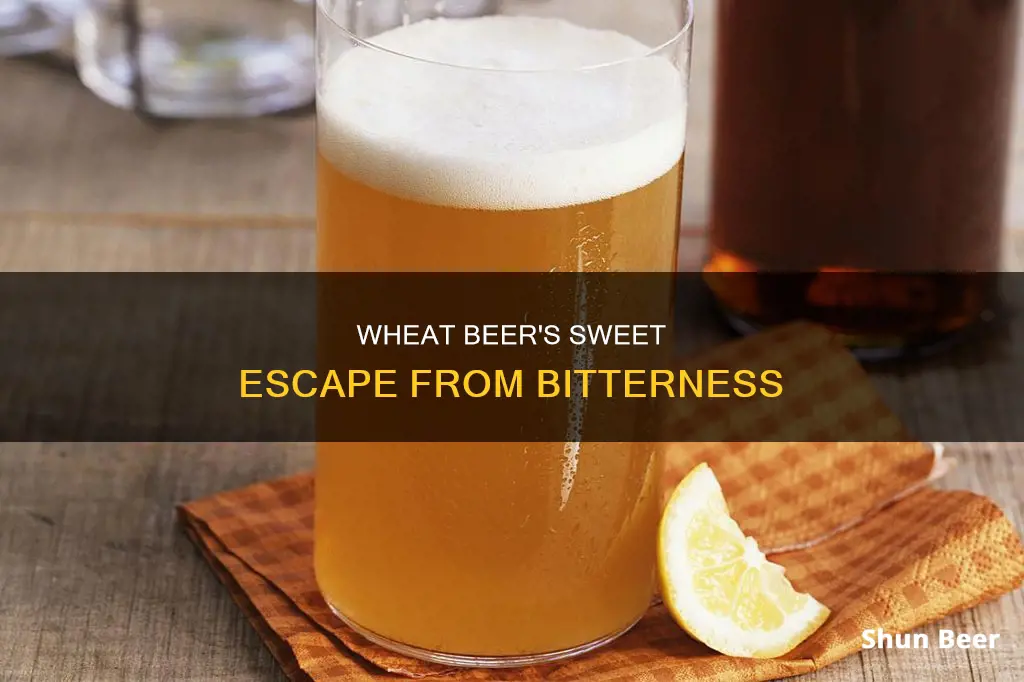
Wheat beer is a top-fermented beer brewed with a large proportion of wheat relative to malted barley. It is considered a light beer, perfect for summer parties. Wheat beers are typically less bitter due to the lack of hops or less hopping in the brewing process. The two main varieties are German Weizenbier and Belgian Witbier, with the former being the largest-selling drink for many microbreweries in India due to its lightness, low bitterness, and fruity flavour. Wheat beers have a distinctive cloudy, hazy appearance due to the use of ale yeast, which ferments on top and creates a creamy sensation when drinking.
| Characteristics | Values |
|---|---|
| Bitterness | Less bitter due to the lack of hops or less hopping |
| Taste | Dry, easy to drink, light sour, fruity |
| Appearance | Pale yellow, cloudy, hazy |
| Mouth feel | Medium feel, creamy |
| Calories | More calories than other light beers |
| Alcohol content | Low to moderate |
| Popularity | Widely popular, especially in the summer |
What You'll Learn

Wheat beer is less bitter due to the lack of hops
Wheat beer is a unique style of beer that has gained popularity, especially among craft beer enthusiasts. One of the defining characteristics of wheat beer is its reduced bitterness compared to other beers. This attribute can be largely attributed to the lack of, or reduced presence of hops in the brewing process.
Hops are a key ingredient in many beers, known for imparting bitterness and contributing to the overall flavour profile. However, in wheat beer, the emphasis is often on other ingredients, which gives it its distinctive taste and aroma. Wheat beer typically contains at least 50% wheat, with the remaining grains being barley, rye, corn, or other grains. This high wheat content gives wheat beer its characteristic haze and pale yellow colour.
The lack of hops in wheat beer results in a more subtle bitterness, allowing other flavours to shine through. For example, German wheat beers are known for their clove and banana flavours, while Belgian wheat beers offer a coriander and orange peel taste. These additional flavours are often derived from the specific yeasts used in the brewing process, which can vary the flavour profile from vanilla to bubble gum.
The reduced bitterness in wheat beer makes it an excellent choice for those who prefer a lighter, easier-drinking beer. It suits the palate of those who are looking for a refreshing, fruity beer without an overpowering bitter taste. This characteristic has contributed to the popularity of wheat beer, especially in craft beer segments, as it provides a unique alternative to the traditional bitterness of lagers and IPAs.
Wheat beer's low bitterness also makes it a versatile beverage, pairing well with various foods and occasions. Its light and refreshing nature makes it a perfect choice for summer parties or as a casual drink to enjoy with friends. The reduced bitterness also appeals to a broader range of consumers, including those who may not typically enjoy the strong bitterness associated with some beer styles.
Pabst: A Wheat Beer or Not?
You may want to see also

Wheat beers are ales, not lagers
Wheat beer is a top-fermented beer, typically brewed with a large proportion of wheat—at least 30%—relative to the amount of malted barley. It is considered a light beer, perfect for summer parties. Wheat beers are usually ales, not lagers. They use ale yeast in the fermenting process, which gives the beer a hazy look because the yeast ferments on the top rather than at the bottom, clouding up the colour.
Wheat beers and lagers are often compared since they are both frequently light in colour, low in bitterness, and relatively low in alcohol. However, lagers are bottom-fermented and can be made with corn, barley, rice, or any combination of those grains. Wheat beers, on the other hand, are usually top-fermented ales and must contain a high percentage of malted or unmalted wheat.
The two main varieties of wheat beer are German Weizenbier and Belgian Witbier. Other types include Lambic (made with wild yeast), Berliner Weisse (a cloudy, sour beer), and Gose (a sour, salty beer). Wheat beer is more of a category than a style of beer and includes several different varieties.
Wheat beers are typically light in colour, low to medium in alcohol content, and can be cloudy or clear in appearance. They tend to lack bitterness, making them easy to drink. The Hefeweizen style, for example, is known for its low hop bitterness (about 15 IBUs) and relatively high carbonation.
Wheat beers are best served at 45 to 50 degrees Fahrenheit in a flute or vase glass. When pouring, tilt the glass almost horizontally and set the mouth of the bottle inside, pouring slowly along the side of the glass. Once most of the beer has been poured, tilt the glass up and pour faster, creating a generous foamy head.
Mashing Wheat Beer: A Guide to the Perfect Mash
You may want to see also

Wheat beers are light and refreshing
Wheat beers are known for their refreshing taste, which is often described as fruity and spicy. The fruity notes come from the yeast used in the brewing process, while the spicy flavour comes from the addition of hops. This slight bitterness balances the sweetness of the malt, resulting in a well-rounded and easy-to-drink beer.
Wheat beer has a long history that dates back to the 16th century in Bavaria, Germany, where it was named "Weissbier", meaning "white beer" due to its cloudy appearance. Today, wheat beer is enjoyed worldwide and is particularly popular in craft breweries, where it is loved for its lightness and low bitterness.
The Belgian wheat beer, for example, has a coriander and orange flavour, while the German wheat beer features notes of clove and banana. These beers are often served with a slice of orange, enhancing their refreshing qualities.
In addition to their delightful taste, wheat beers also offer health benefits. They are a rich source of vitamins and minerals, including vitamin B, iron, magnesium, and potassium. So, not only do wheat beers provide a delightful drinking experience, but they can also contribute to your overall well-being.
What's the Difference Between Wheat and Witbier?
You may want to see also

Wheat beers are hazy in appearance
Wheat beers are characterised by their cloudy, hazy appearance. This is due to the top fermentation of the ale yeast used in the brewing process. The yeast ferments on top, rather than at the bottom of the liquid, which clouds the colour. The haze can also be attributed to the high amount of wheat proteins floating in the beer.
The haze in wheat beers is so distinctive that it has inspired the names of some wheat beer brands, such as Allagash White, which has a hazy, pale yellow appearance. Wheat beers are also lighter in colour than other beers, such as pale ales.
The haze in wheat beers is not to be confused with the haze in New England IPAs, which is caused by a combination of the malt profile and the way the beer is hopped. Wheat beers are not particularly hoppy, which contributes to their lower bitterness.
Sour Beers: Do They Contain Wheat?
You may want to see also

Wheat beers are fruity
Wheat beers are often fruity. Belgian wheat beer, for example, has a coriander and orange flavour, while German wheat beer has a clove and banana flavour. Wheat beers are considered ales, not lagers, and are brewed using ale yeast, which ferments at a higher temperature than lager yeast. This gives wheat beers a fruity profile, with a light, spicy, pepper-like character that makes them easy to drink.
The fruitiness of wheat beer can also be enhanced by adding fruit or fruit extracts. Fruit wheat beers typically contain at least 30% malted wheat, with the remaining grains being barley or other grains. The fruit or fruit extracts contribute aroma and flavour, expressing true fruit complexity. Popular fruits used in wheat beers include apricots, peaches, raspberries, figs, and dragon fruit.
Some wheat beers are also brewed with spices such as coriander, which can enhance the fruity flavour. American wheat beers, for example, often have citrus, vanilla, or bubblegum flavours added to them. These flavours can be enhanced by adding fruit, such as oranges or grapefruit, to the beer.
Wheat beers are typically less bitter than other beers due to the lack of hops or reduced hopping. The combination of fruitiness and low bitterness makes wheat beers a popular choice, especially during the summer months.
Asahi Beer: Wheat-Free or Not?
You may want to see also
Frequently asked questions
Yes, wheat beer is less bitter than other beers. This is due to the low amount of hops used in the brewing process.
Wheat beer is a top-fermented beer brewed with a large proportion of wheat relative to the amount of malted barley. Wheat beers are considered ales, not lagers, and are often light and refreshing.
Wheat beer has a dry, less bitter taste due to the lack of hops. It also has a creamy mouthfeel and a fruity profile, with notes of clove, banana, coriander, and orange.
Popular wheat beer brands include Blue Moon, Shock Top, Erdinger, Paulaner, and Franziskaner.







